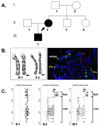Clinical and genomic characterization of distal duplications and deletions of chromosome 4q: study of two cases and review of the literature
- PMID: 19921640
- PMCID: PMC2788106
- DOI: 10.1002/ajmg.a.33088
Clinical and genomic characterization of distal duplications and deletions of chromosome 4q: study of two cases and review of the literature
Abstract
Variable clinical presentations of patients with chromosomally detected deletions in the distal long arm (q) of chromosome 4 have been reported. The lack of molecular characterization of the deletion sizes and deleted genes hinders further genotype-phenotype correlation. Using a validated oligonucleotide array comparative genomic hybridization (oaCGH) analysis, we examined two patients with apparent chromosomal deletions in the distal 4q region. In the first, oaCGH identified a 2.441 megabase (Mb) duplication and a 12.651 Mb deletion at 4q34.1 in a pregnant female who transmitted this aberration to her son. This mother has only learning disabilities while her son had both renal and cardiac anomalies in the newborn period. Unrecognized paternal genetic factors may contribute to the variable expression. The second patient is a 17-year-old female with a history of Pierre Robin sequence, cardiac abnormalities and learning disabilities. She was diagnosed prenatally with a de novo 4q deletion, and oaCGH defined a 16.435 Mb deletion of 4q34.1-4q35.2. Phenotypic comparison and subtractive genomic mapping between these two cases suggested a 4 Mb region possibly harboring a candidate gene for Pierre Robin sequence. Our cases and review of reported cases with genomic findings indicated the presence of familial variants with variable expressivity as well as de novo or inherited pathogenic simple deletion, duplication and complex deletion and duplication in the distal 4q region.
Figures




Similar articles
-
Molecular characterization of distal 4q duplication in two patients using oligonucleotide array-based comparative genomic hybridization (oaCGH) analysis.Am J Med Genet A. 2014 Apr;164A(4):1069-74. doi: 10.1002/ajmg.a.36396. Epub 2014 Jan 23. Am J Med Genet A. 2014. PMID: 24459084
-
Molecular cytogenetic characterization of a 2q35-q37 duplication and a 4q35.1-q35.2 deletion in two cousins: a genotype-phenotype analysis.Am J Med Genet A. 2015 Jul;167(7):1551-9. doi: 10.1002/ajmg.a.37063. Epub 2015 Apr 6. Am J Med Genet A. 2015. PMID: 25851921
-
Analytical and clinical validity of whole-genome oligonucleotide array comparative genomic hybridization for pediatric patients with mental retardation and developmental delay.Am J Med Genet A. 2008 Aug 1;146A(15):1942-54. doi: 10.1002/ajmg.a.32411. Am J Med Genet A. 2008. PMID: 18627053
-
Molecular cytogenetic characterization of a 4p15.1-pter duplication and a 4q35.1-qter deletion in a recombinant of chromosome 4 pericentric inversion.Am J Med Genet A. 2009 Feb;149A(2):226-31. doi: 10.1002/ajmg.a.32603. Am J Med Genet A. 2009. PMID: 19161154 Review.
-
Prenatal Diagnosis of 4q Terminal Deletion and Review of the Literature.Cytogenet Genome Res. 2019;158(2):63-73. doi: 10.1159/000500735. Epub 2019 Jul 2. Cytogenet Genome Res. 2019. PMID: 31261151 Review.
Cited by
-
Cytogenomic characterization of a de novo 4q34.1 deletion in a girl with mild dysmorphic features and a coagulation disorder.Mol Cytogenet. 2021 Sep 4;14(1):43. doi: 10.1186/s13039-021-00564-z. Mol Cytogenet. 2021. PMID: 34481514 Free PMC article.
-
A Two-Month-Old Child with Vascular Ectasia: A Case Report Diagnosed by Molecular Karyotyping.J Pediatr Genet. 2019 Mar;8(1):20-23. doi: 10.1055/s-0038-1669385. Epub 2018 Aug 22. J Pediatr Genet. 2019. PMID: 30775049 Free PMC article.
-
Clinical evaluation of rare copy number variations identified by chromosomal microarray in a Hungarian neurodevelopmental disorder patient cohort.Mol Cytogenet. 2022 Nov 1;15(1):47. doi: 10.1186/s13039-022-00623-z. Mol Cytogenet. 2022. PMID: 36320065 Free PMC article.
-
4q34.1-q35.2 deletion in a boy with phenotype resembling 22q11.2 deletion syndrome.Eur J Pediatr. 2011 Nov;170(11):1465-70. doi: 10.1007/s00431-011-1533-3. Epub 2011 Jul 22. Eur J Pediatr. 2011. PMID: 21833498
-
Genome-wide copy number variant analysis for congenital ventricular septal defects in Chinese Han population.BMC Med Genomics. 2016 Jan 8;9:2. doi: 10.1186/s12920-015-0163-4. BMC Med Genomics. 2016. PMID: 26742958 Free PMC article.
References
-
- Balikova I, Menten B, de Ravel T, Le Caignec C, Thienpont B, Urbina M, Doco-Fenzy M, de Rademaeker M, Mortier G, Kooy F, van den Ende J, Devriendt K, Fryns JP, Speleman F, Vermeesch JR. Subtelomeric imbalances in phenotypically normal individuals. Hum Mutat. 2007;28:958–967. - PubMed
-
- Caliebe A, Waltz S, Jenderny J. Mild phenotypic manifestations of terminal deletion of the long arm of chromosome 4: clinical description of a new patient. Clin Genet. 1997;2:116–119. - PubMed
-
- Charité J, McFadden DG, Olson EN. The bHLH transcription factor dHAND controls Sonic hedgehog expression and establishment of the zone of polarizing activity during limb development. Development. 2000;127:2461–2470. - PubMed
-
- Descartes M, Keppler-Noreuil K, Knops J, Longshore JW, Finley WH, Carroll AJ. Terminal deletion of the long arm of chromosome 4 in a mother and two sons. Clin Genet. 1996;50:538–540. - PubMed
-
- Fryns JP, Timmermans J, Hoedemaekers J, Emmery L, Van den Berghe H. Pierre-Robin anomalad, moderate mental retardation and distal 4q deletion. Ann Genet. 1981;24:187–188. - PubMed
Publication types
MeSH terms
Grants and funding
LinkOut - more resources
Full Text Sources
Miscellaneous

